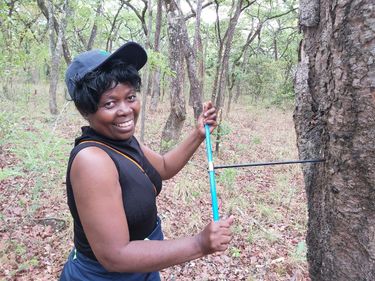
Sessions in which Nicole Zampieri participates
Wednesday 29 June, 2022
The Miombo woodlands of interior Africa are fire adapted ecosystems with a relatively open canopy dominated by Brachystegia spp., Julbernardia spp., and Isoberlina spp. These ecosystems are threatened due to deforestation, habitat fragmentation, and impacts from climate change, and in Zambia, they are further threatened by the rapidly growing mining industry which contributes to air pollution, contamination of soils and water, and land degradation. In this study, we used modified variable ...
Thursday 30 June, 2022
Allies have emerged as key enablers of diversity and inclusivity initiatives in the workplace, in professional associations, and in everyday life. But what is an ally? What skills are required to be an effective ally? How do we hold ourselves and our community members accountable for being effective allies? This symposium will provide a deeper understanding of what it means to be an ally and the skills to help advance allyship as individuals and as a community. Fur...
Sessions in which Nicole Zampieri attends
Monday 27 June, 2022
MAIDENiso is a numerical process-based model that allows researchers to simulate the growth of a virtual tree. Using daily meteorological data, the model simulates the physical and physiological processes taking place in the tree and its environment, to produce daily and yearly outputs comparable to dendrological observations. The model has been adapted and used successfully in boreal regions in North America. In an inverse mode, tree-ring obs...
Free, in person and onlineWe will hold a practical, skills-based workshop introducing openDendro -- an open-source framework of the base analytic software tools used in dendrochronology in both the R and Python programming languages. openDendro is a new unified set of tree-ring analysis tools in open-source environments that provides the necessary baseline for dendro...
Meet colleagues and friends in an informal settingFree drinks for all!
Tuesday 28 June, 2022
Africa is faced with a number of challenges including climate change and ecological disturbance due to various anthropogenic activities. These problems adversely affect the forests and also ecosystem services. My appreciation for the forests motivated me to pursure my undergraduate studies in Forestry. I first applied dendrochronology during my PhD research which focused on understanding the climate change vulnerability of the Zambezi teak forests in Zambia. However, lack of research facil...
Tree-ring time series provide long-term, annually resolved information on the growth of individual trees. However, public tree-ring archives contain a considerable portion of data collected from trees that have been selected with specific research questions in mind (e.g., for climate reconstruction). This makes these archives a biased representation of the sensitivity of forest ecosystems to ongoing climate variation (e.g. temperature, precipitation), including non-stationarity (i.e....
Tree-ring research studies depend heavily on samples, but the connection to the sampling theory remains loose. Tree-ring studies need to be based on samples of restrained size for several reasons: measuring tree-ring features remains labour-intensive, costly, and sampling cannot be seen as totally free of consequences for trees. Sampling, the art of selecting observational units to produce population-level estimates, comes with constraints that, when not respected, lead to biases and loss ...
Climate change poses an existential threat to trees, given our understanding of the importance of climate in shaping their geographic distributions. Climate envelope models are commonly used to predict how species will respond to climate change. These models give rise to the leading edge-trailing edge paradigm for range change: populations at the cool edge of a species’ distribution are expected to benefit from warming, whereas populations at the warm edge are expected to decline. We chall...
Forest responses to climate change are highly uncertain, but critical for forecasting and managing forest carbon dynamics. Tree-ring time series data provide annually resolved growth responses to climate, but often lack the stand-level information needed to scale growth up to carbon uptake. In contrast, the U. S. Forest Service Forest Inventory and Analysis (FIA) Program is an exceptional spatial network to estimate forest carbon, but lacks the annual resolution needed to determine how tre...
Evidence of volcanic cooling and its human impacts has been described for various regions of the globe over the past several centuries to millennia, derived from paleoclimatic and historical data. Due to its remote location, detailed accounts of such impacts over Northwestern North America (NWNA) are still quite limited. Here we use a newly expanded tree-ring density network (derived from blue intensity as well as maximum latewood density parameters) to assess the climatic and human impact...
Past forest mortality after disturbances creates one source of uncertainty that needs to be taken into account to reconstruct biomass dynamics. Additionally, using unitless normalized data from tree-ring records to calibrate stand productivity in vegetation models constitutes another source of uncertainty for model calibration. In this presentation I would assess these two sources of uncertainty and discuss the influence of calibration technique in model-data fusion. I combined data from p...
Tree-ring time series provide long-term, annually resolved information on the growth of individual trees. When sampled in a systematic context, tree-ring data can be scaled to estimate the forest carbon capture and storage of landscapes, biomes, and ultimately the globe. A systematic effort to sample tree rings in national forest inventories would yield unprecedented temporal and spatial resolution of forest carbon dynamics, and help resolve key scientific uncertainties, which we highlight...
Tree-ring time series provide long-term, annually resolved information on the growth of individual trees. However, public tree-ring archives contain a considerable portion of data collected from trees that have been selected with specific research questions in mind (e.g., for climate reconstruction). This makes these archives a biased representation of the sensitivity of forest ecosystems to ongoing climate variation (e.g. temperature, precipitation), including non-stationarity (i.e....
The past and future of forests are unequivocally controlled and determined by global climate. Constraining the uncertainties within this multifaceted relationship has been the focus of vast research efforts. A spatial perspective, however, is often neglected. Using the geographical constraints (e.g. latitude, altitude) and climatic drivers of tree dynamics as a benchmark, we address the spatial patterns and changes of forest growth at a continental scale and quantify the forest growth resp...
Ultra high resolution imaging is becoming standard across the sciences and must be a priority for dendrochronology. Large format scanners fail to resolve micro rings and the anatomical structures of increasing scientific interest. Meanwhile, current software limitations include cost, user experience, data management flexibility, and capacity for handling large file sizes. We argue for a new paradigm and present a technology framework that integrates gigapixel macro photography, a cloud-hos...
Montane forests of Central Europe are experiencing faster changes in climate than the average trends. It is still unclear how these natural forests, and especially saplings, have responded to recent modifications in growth conditions. We took advantage of the REMOTE forests network to look at the changes in juvenile growth rates of Norway spruce and European beech, two economically important tree species in Europe. This network includes ring-widths series of more than 19,000 spruces and 14...
Tree-ring research has given generations of scientists a long memory of what is acceptable for a tree to be included for data analysis. The established criteria, however, were set through purposeful goals to maximize the response for climatic reconstructions. Ecology is different. Tree-rings are increasingly being used to study a wide swath of ecology, including the carbon cycle or the response of ecosystems to global changes. A fundamental aspect of ecology is to understand the range of r...
In this work we show the application of dendrochronology as an educational resource for schoolchildren and as a mean to disseminate science to society. Tree rings are popularly known in Chile due to the massive use of wood for construction, handicrafts and firewood. The visible tree rings generate a distinct, tangible and familiar curiosity in many people. “Tree-Rings as a Natural Encyclopedia of Environmental Archives” is an exhibition built as an educational project for schoolchildren, w...
Historical accounts in the Brazilian Digital Library provide independent support for most of the tree-ring reconstructed wet season rainfall extremes in the eastern Amazon during the late-18th and 19th centuries. Newspapers, government reports, and other documents describe crop failure, livestock mortality, water shortages, and ship groundings on the Amazon River during many of the tree-ring reconstructed drought extremes. Heavy rains and flooding are described during some of the wet extre...
In the context of climate and environmental change, the boreal forest is subject to potential changes in structure and function. Stand-level physiological models can be used to predict these responses over time and to understand the interaction between tree ecophysiological processes and climate variability. We present here a project that aims to develop potential growth scenarios for Canadian boreal forest stands based on the characterization of their ecosystem fluxes using the MAIDEN mod...
The impacts of inland flooding caused by tropical cyclones (TCs), including loss of life, infrastructure disruption, and alteration of natural landscapes, have increased over recent decades. While these impacts are well documented, changes in TC precipitation extremes—the proximate cause of such inland flooding—have been more difficult to detect. Here, we present a latewood tree-ring–based record of seasonal (June 1 through October 15) TC precipitation sums (ΣTCP) from the region in North ...
The representation of snow processes in forest growth models is necessary to accurately predict the hydrological cycle in boreal ecosystems and the isotopic signature of soil water extracted by trees, photosynthates and tree-ring cellulose. Yet, most process-based models do not include a snow module, consequently their simulations may be biased in cold environments. Here, we modified the MAIDENiso model to incorporate a new snow module that simulates snow accumulation, melting and sublimat...
"Little is known about the impact of volcanoes on trees from the Southern Hemisphere. In this study, we investigated whether volcanic signals could be identified in ring widths from eight dendrochronological species from New Zealand, using superposed epoch analysis. We found that most species are good recorders of volcanic dimming and that the magnitude and persistence of the post-event response can be broadly linked to plant life history traits - whether the species responds as a 'stress ...
The most frequent fire regimes in the world exist in environments that balance maximum fuel production and maximum fire occurrence potential. Often these environments exist at low elevations, correspond to subtropical climates, and have long growing seasons that push the limits of reliable annual ring formation. Historical fire regimes in ecosystems with these conditions are poorly studied. We investigated fire scarring in such conditions in southwestern Georgia, USA and successfully const...
Drought, flooding, and hurricane activity disrupt the human and natural landscape throughout the southeastern United States. Instrumental records through the past century suggest that the patterns of these extreme events are changing through time, especially in relation to rising global temperatures. However, instrumental records before the industrial revolution are rare, thus proxy records like tree rings are useful for comparing climatological conditions before massive human modification...
We report on research to develop quantitative, annually resolved, multi-century, tree-ring reconstructions of streamflow for 12 interstate river systems in eight states (Alabama, Florida, Georgia, Louisiana, Mississippi, North Carolina, South Carolina, and Virginia) in the South Atlantic Gulf Basin (AGB) of the southeastern United States.We used a nested principal components regression method to develop annually resolved tree-ring reconstructions of warm-season (March-October streamflo...
Insect and pathogen outbreaks, fires, hurricanes, severe drought and other disturbances alter the structure, composition and function of forests. Results from silvicultural experiments suggest disturbances in lower density forests lead to better mitigation of drought stress for surviving trees than those in higher density stands. As drought and insect and pathogen outbreaks are expected to become more severe and frequent, understanding how surviving trees’ climatic response is affected by ...
Wednesday 29 June, 2022
Dendrochronology is considered one the most precise of all the scientific dating techniques. However, it requires long sequences of tree rings and a master record for both the species and region in question. At the University of Groningen, we have been pioneering a new approach to dating that combines the precision of dendrochronology with the versatility of radiocarbon dating. It relies on the detection of spikes in the annual radiocarbon record, thought to b...
Carbon-14 (14C) is produced via a nuclear reaction between the atmosphere and cosmic rays. Although the main source of 14C is galactic cosmic rays, solar energetic particles (SEPs) also contributes in producing 14C. Extreme SEP events are considered to produce 14C spikes that considerably exceed the 14C amount produced by galactic cosmic rays. Thus far, several signatures of 14C spikes originates by extreme SEP events have been reported, such as the 774 CE, 992 CE, and ~660 BCE events. In ...
"Drought legacy effects (DLE) in radial tree growth (RTG) have been extensively studied over the last decade and are found to critically influence carbon sequestration in woody biomass. However, the statistical significance of DLE depends on our definition of expected vs. unexpected growth variability, a definition that has not received sufficient scrutiny.Here, we revisit popular DLE analyses using the ITRDB and employ a synthetic data simulation to disentangle four key factors influe...
Dendroclimatology in the tropical forest regions has lagged behind the more temperate forested regions of the world because of the challenge of determining annual ring formation. Despite over 230 tropical tree species known to form annual rings, the ITRDB shows few published chronologies in tropical forests in Sub-Saharan Africa. As part of the first “Training in Tree-Ring Science and its Applications” workshop conducted in Kitwe, Zambia, our team explored the dendroclimatic potential of B...
It has been shown that trees get older in the wet tropics, but the mechanisms behind this observation are still not clear. Literature shows that moisture could directly affect longevity by modulating physiological processes of trees. Other studies point to the potential role of water on tree size, which could indirectly affect longevity if one reconciles to the fact that the growth rate of tropical trees doesn’t differ significantly between wet and dry sites. The third group points to the ...
The impacts of inland flooding caused by tropical cyclones (TCs), including loss of life, infrastructure disruption, and alteration of natural landscapes, have increased over recent decades. While these impacts are well documented, changes in TC precipitation extremes—the proximate cause of such inland flooding—have been more difficult to detect. Here, we present a latewood tree-ring–based record of seasonal (June 1 through October 15) TC precipitation sums (ΣTCP) from the region in North ...
The most frequent fire regimes in the world exist in environments that balance maximum fuel production and maximum fire occurrence potential. Often these environments exist at low elevations, correspond to subtropical climates, and have long growing seasons that push the limits of reliable annual ring formation. Historical fire regimes in ecosystems with these conditions are poorly studied. We investigated fire scarring in such conditions in southwestern Georgia, USA and successfully const...
We report on research to develop quantitative, annually resolved, multi-century, tree-ring reconstructions of streamflow for 12 interstate river systems in eight states (Alabama, Florida, Georgia, Louisiana, Mississippi, North Carolina, South Carolina, and Virginia) in the South Atlantic Gulf Basin (AGB) of the southeastern United States.We used a nested principal components regression method to develop annually resolved tree-ring reconstructions of warm-season (March-October streamflo...
This is a mandatory (!) .... and FREE (!!) cocktail & award ceremony (!!!)(in replacement of the Banquet formula)->->->->->->->->->->->->->->->->->->After a great summer day of scientific and urban discoveries in our beloved MTL, we wish to bring together all the AmeriDendro community in one place and congratulate the TRS awardees for their remarkable achievements! -Bonsinsegna award-Fr...
Thursday 30 June, 2022
How old are tropical trees? This fundamental question has long driven the curiosity of laymen and scientists. But only recently, a great number of studies conducted by many brave dendrochronologists resulted in a significant tree-ring-based knowledge that allows us to start accurately estimating tree ages across the globe. As science goes, not only knowing the longevity of tropical trees is essential to understanding forest dynamics and its role in biogeochemical cycles, but one must also ...
Methodological advances in the latest years have opened new perspectives for dendrochonological studies by facilitating the visualization, delimitation, and analyses of tree-rings. These novel methodologies have incorporated complementary physical and chemical parameters to the traditional anatomical procedures used to describe annual growth rings. Here, we present the results of new studies which explore the relationships among wood density features and chemical elements involved in the a...
The assessment of pre-instrumental climate variability during the Common Era (CE) has been a key element of IPCC reports and was recently emphasized by showing a single temperature reconstruction as the first figure in the 2021 Summary for Policymakers (SPM). This reconstruction is derived from dozens of proxy records including tree-rings, corals, ice cores and sediments, and displays the course of global temperatures over the past 2000 years. Show casing a single study for paleoclimate co...
Dendrochronological archives in the tropics of the Americas have been under-studied for a long time. Some of the challenges include the Identification of tree-ring boundaries in certain tree species, absence of winter dormancy associated to low temperatures in most of the cases, and logistic difficulties of fieldwork in remote sites. However, part of the slow progress is also related to the fact that historically much less resources have been inv...
In tropical environments of central America, tree-ring forming species are rare to find, especially in areas with pronounced aseasonality, but wood anatomical traits can equally provide important information on species life-histories and response to disturbances. Dating wood anatomical structures remains a crucial task to decipher the ecological information recorded in xylem cellular parameters in absence of defined ring boundaries, particularly to observe the footprint of discrete disturb...
In temperature-limited ecosystems such as high-elevation forests, rising temperatures and increasing carbon dioxide can result in a greening effect, and changes in the phenology and tree growth rates of the forests. We assessed the long-term trend dynamics (greenness and land surface phenology) using the Normalized Difference Vegetation Index (NDVI) and compared them with data from an existing dendrochronological network that came from eight protected mountains in the Trans-Mexican Volcani...
Dendrochronological archives in the tropics of the Americas have been under-studied for a long time. Some of the challenges include the Identification of tree-ring boundaries in certain tree species, absence of winter dormancy associated to low temperatures in most of the cases, and logistic difficulties of fieldwork in remote sites. However, part of the slow progress is also related to the fact that historically much less resources have been inv...
The occurrence of annual growth rings in tropical trees—the result of the seasonal activity of vascular cambium—has been explained either by seasonal periods of water deficit or flooding. However, little is known about the drivers of annual tree-ring formation under tropical hyper-humid conditions without evident seasonal dry periods or flooding (ever-wet conditions). Shelford's law states that both the deficit and the excess of environmental resources limit plant growth. Accordingly, we h...
Recent droughts have highlighted concerns of how rising summer temperatures will increase tree mortality rates across the western United States. However, there remains uncertainty about how summer rain might respond to warming and whether this will ameliorate the moisture stress associated with warming. We analyzed subfossil wood samples from Colorado dating to the last interglacial to assess the response of two common conifers to a previous warm period. The trees experienced comparable gr...
The Caribbean, like much of the tropics, is underrepresented by tree-ring chronologies making global climate reconstructions a challenge because of these blind spots. We have developed a multi-centennial tree-ring chronology from 120 samples of Pinus occidentalis trees located above 2800 m elevation on the dry slopes of Loma la Pelona in the Cordillera Central (19.035278 N, -71.005278 W) of the Dominican Republic. We used skeleton plotting on multiple radii from each crossection to date th...
A gap of millennial tree-ring data suitable for dendroclimatology has long been evident in the North American boreal forest. In my talk, I will describe the adaptive approach we have developed to build and improve a data network for millennial dendroclimatology in the eastern Canadian taiga. Recurrence of stand replacing wildfires is the most important constrain to the elaboration of long tree ring chronologies, which can only be developed away from regions ...





